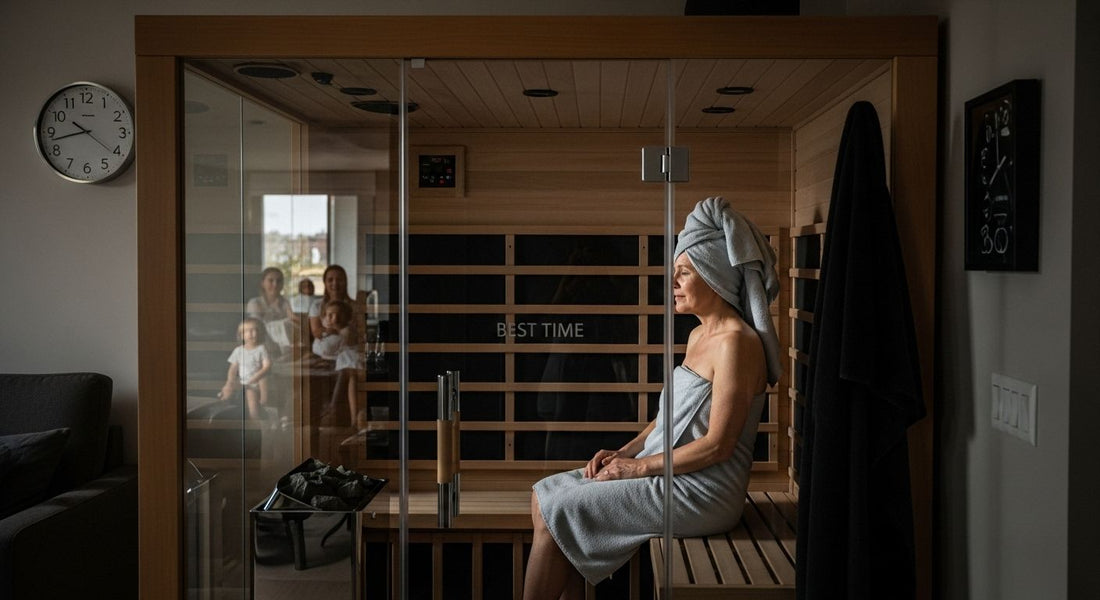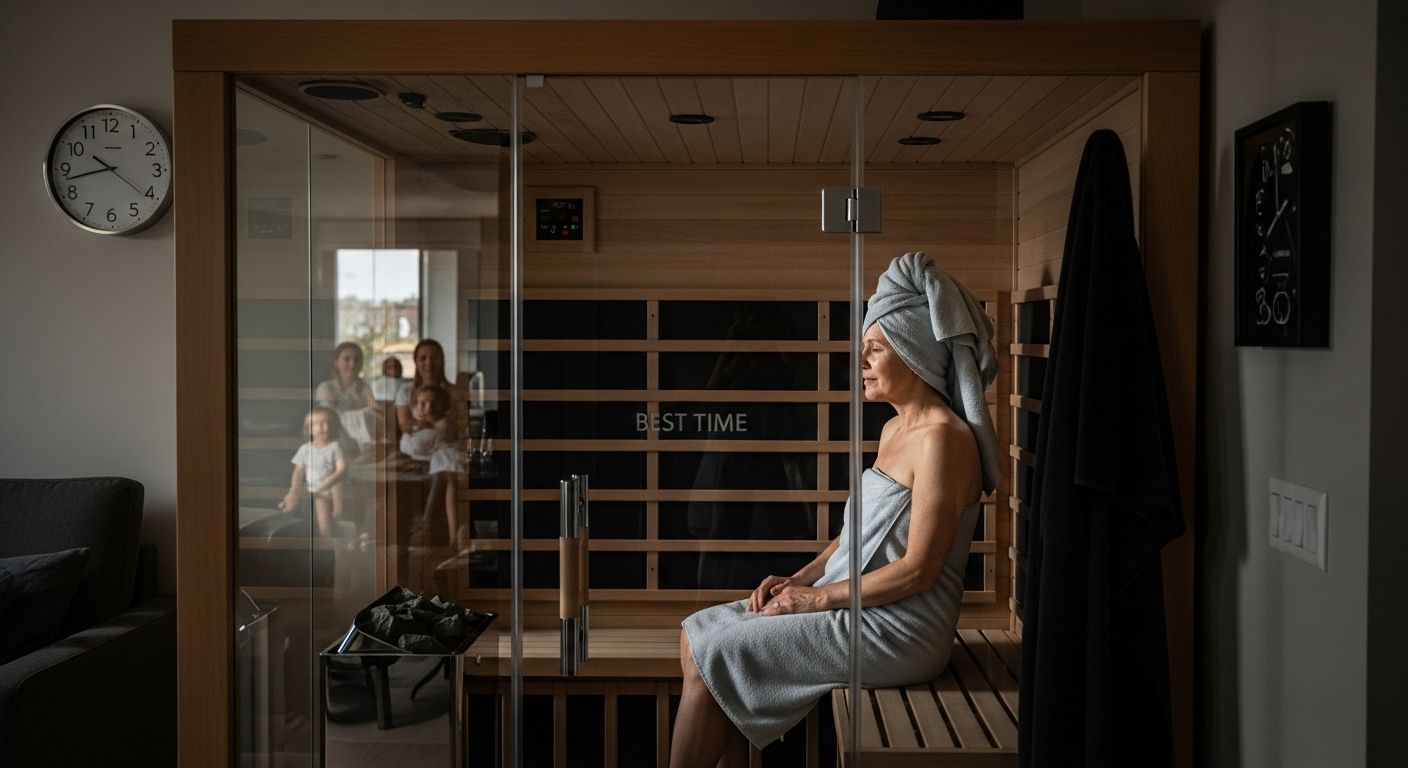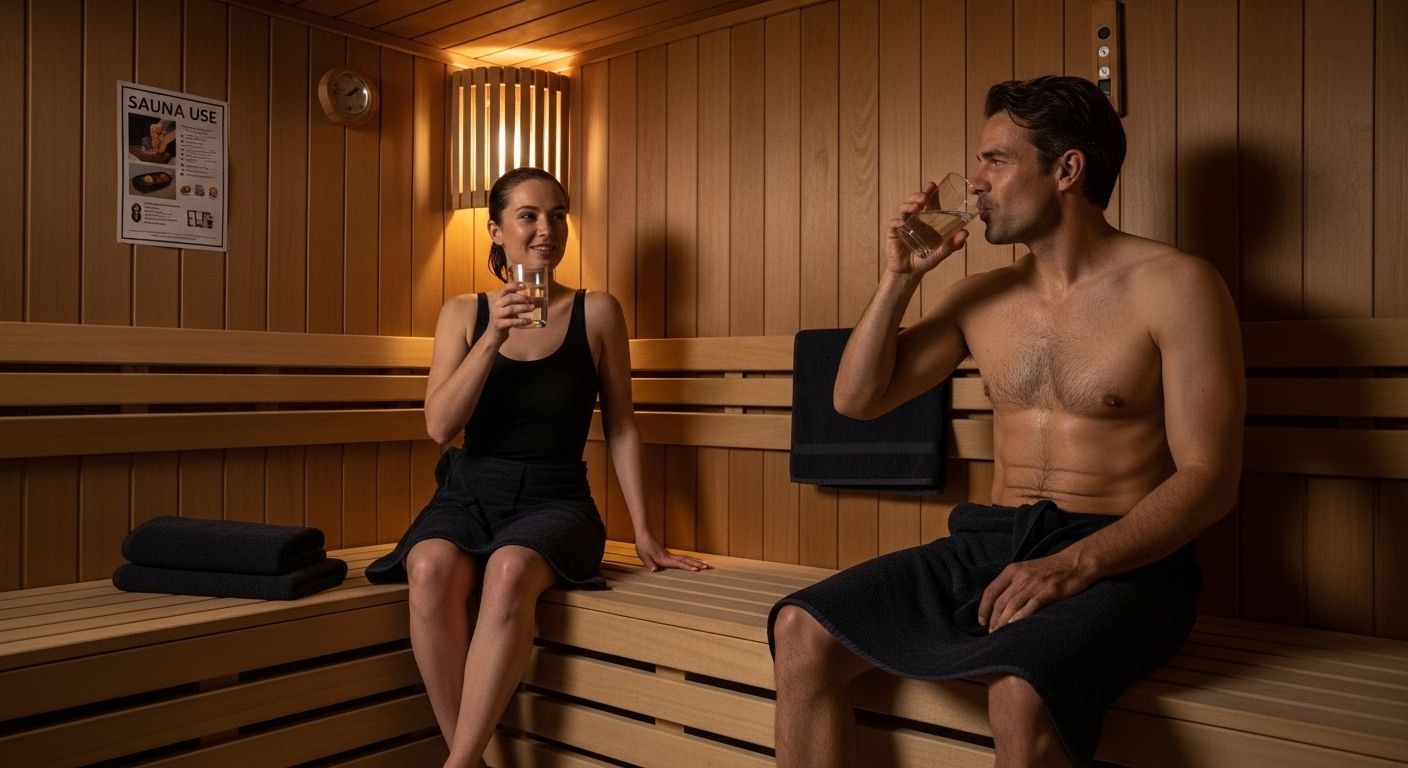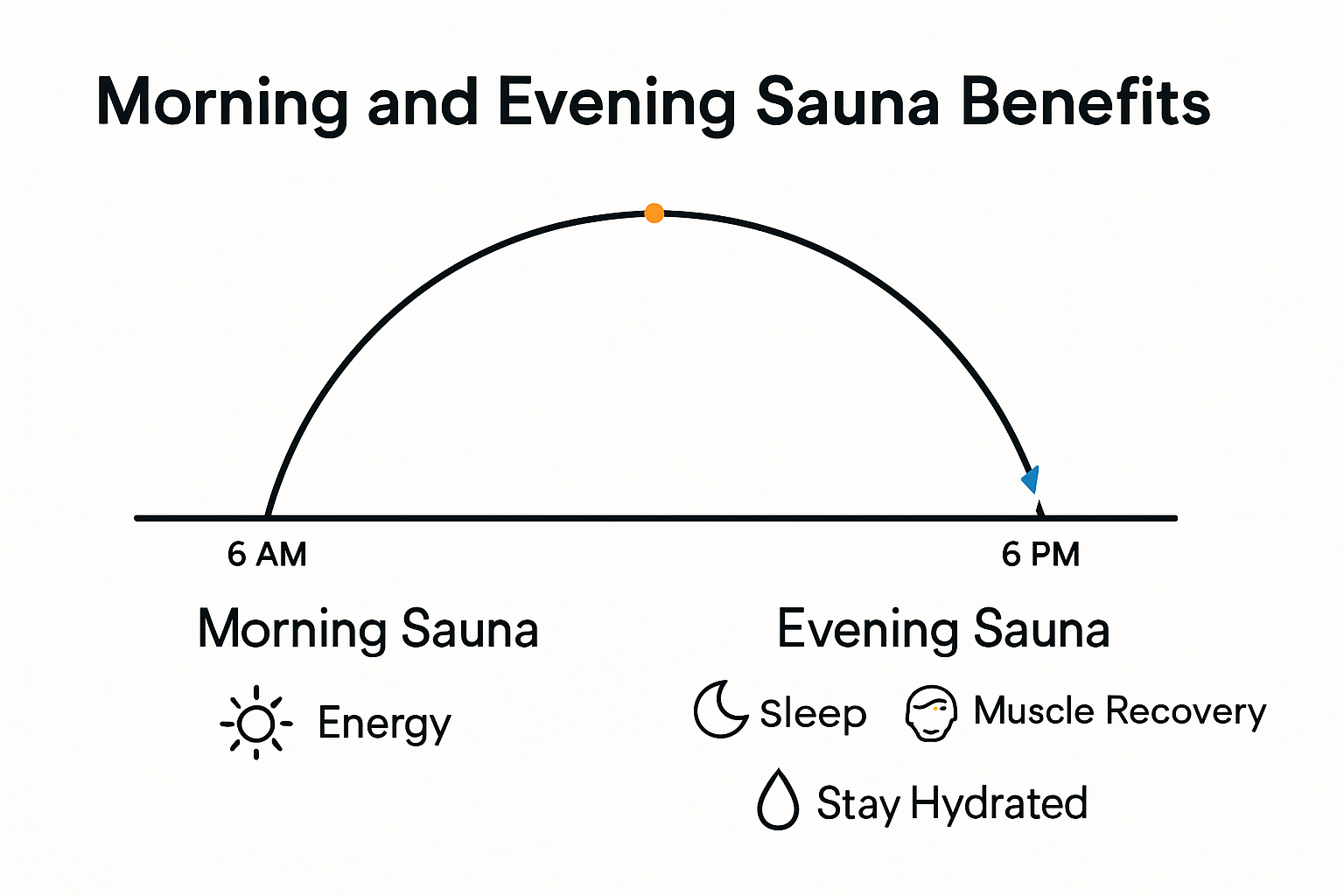
Understanding the Best Time of Day for Sauna Use
Morning or evening, stepping into a sauna promises real wellness rewards. Studies show that your core body temperature peaks nearly every afternoon, while it hits rock bottom in the early morning hours. Surprising, right? Many people chase relaxation at night or alertness at sunrise, but the real secret may be letting your body’s own clock decide when you should sweat.

Table of Contents
- Exploring The Benefits Of Sauna Use At Different Times
- The Science Behind Sauna Timing And Body Rhythms
- How Personal Schedules Influence Sauna Effectiveness
- Seasonal Variations In Sauna Usage Recommendations
Quick Summary
| Takeaway | Explanation |
|---|---|
| Use saunas in the morning for energy. | Morning sessions stimulate circulation and metabolism, preparing you for daily activities and improving mental alertness. |
| Evening sauna aids relaxation and sleep. | Evening sessions help release muscle tension and reduce stress, promoting better sleep quality through heat-induced relaxation. |
| Tailor sauna use to your personal schedule. | Align sauna sessions with work and fitness routines to enhance cognitive performance and recovery, ensuring they’re effective for your lifestyle. |
| Consider seasonal adaptations for sauna use. | Adjust sauna practices based on seasons, such as focusing on hydration in summer and utilizing contrast therapy in winter for added benefits. |
| Listen to your body’s responses during sessions. | Pay attention to how your body reacts to temperature changes and sessions, allowing for better personalization of your sauna experience. |
Exploring the Benefits of Sauna Use at Different Times
Understanding the optimal time for sauna use involves recognizing how different periods of the day can impact your physiological and psychological responses. While sauna sessions offer numerous health benefits, the timing can significantly influence their effectiveness and your overall wellness experience.
Morning Sauna Sessions: Energizing and Preparing for the Day
Morning sauna use can provide a powerful start to your day. By exposing your body to heat early in the morning, you stimulate circulation, boost metabolism, and enhance mental alertness. Research from Mayo Clinic Proceedings suggests that morning heat exposure can help regulate your body’s natural rhythms and prepare you for upcoming physical or mental challenges.
Key benefits of morning sauna sessions include:
- Increased core body temperature that jumpstarts metabolic processes
- Enhanced blood circulation and cardiovascular function
- Improved mental clarity and focus for daily activities
Evening Sauna Sessions: Relaxation and Recovery
Evening sauna sessions offer a different set of advantages, primarily focused on relaxation and recovery. As the day winds down, a sauna can help release muscle tension, reduce stress, and promote better sleep quality. According to Evidence-Based Complementary and Alternative Medicine, the body’s response to heat therapy in the evening can trigger a cascade of physiological changes that support relaxation and prepare you for restful sleep.
Notable benefits of evening sauna use include:
- Muscle relaxation after physical activity
- Stress reduction through heat-induced endorphin release
- Improved sleep onset and overall sleep quality

To help you compare the effects and ideal uses of sauna sessions at different times of day, here is a table summarizing the benefits and purposes of morning versus evening sauna routines:
| Time of Day | Key Benefits | Best For |
|---|---|---|
| Morning | Stimulates circulation and metabolism | |
| Enhances mental alertness | Energizing the start of your day | |
| Preparing for physical/mental challenges | ||
| Evening | Releases muscle tension | |
| Reduces stress | ||
| Promotes better sleep | Relaxation and recovery | |
| Improving sleep quality |
Ultimately, the best time for sauna use depends on your personal goals, schedule, and individual physiological responses. Some individuals might find morning sessions more invigorating, while others may prefer the calming effects of an evening sauna. Experimenting with different times can help you discover the most beneficial approach for your wellness routine.
The Science Behind Sauna Timing and Body Rhythms
Understanding sauna timing requires insight into our body’s intricate biological clock and how heat exposure interacts with our circadian rhythms. The human body operates on a complex system of internal processes that fluctuate throughout the day, influencing physiological responses and overall wellness.
Circadian Rhythms and Temperature Regulation
Our body experiences natural temperature variations that follow a predictable daily pattern. Research from Frontiers in Neurology reveals that core body temperature follows a specific cycle, typically peaking in the late afternoon between 4 p.m. and 6 p.m., and reaching its lowest point in the early morning hours. These temperature fluctuations are controlled by our internal biological clock, which impacts multiple physiological functions.
Key aspects of circadian temperature rhythms include:
- Natural temperature peak occurs around late afternoon
- Lowest body temperature happens in early morning hours
- Internal biological clock drives these temperature variations

Physiological Responses to Heat Exposure
Sauna sessions trigger a complex set of physiological responses that interact with our body’s natural rhythms. When exposed to heat, the body initiates a series of adaptive mechanisms designed to maintain homeostasis. According to Journal of Clinical Endocrinology & Metabolism, these responses can significantly influence cognitive performance, alertness, and overall neurological function.
Important physiological responses during sauna use include:
- Increased heart rate and blood circulation
- Activation of heat shock proteins
- Mild stress response that potentially enhances cellular resilience
The interaction between sauna timing and body rhythms suggests that strategic heat exposure can potentially optimize physiological adaptations. By understanding these intricate relationships, individuals can more effectively incorporate sauna sessions into their wellness routines, maximizing potential health benefits while working in harmony with the body’s natural cycles.
How Personal Schedules Influence Sauna Effectiveness
Personal schedules play a critical role in determining the optimal timing and effectiveness of sauna sessions. Individual lifestyle factors, work patterns, fitness routines, and personal wellness goals all contribute to creating a personalized approach to sauna use that maximizes potential health benefits.
Work and Fitness Schedules
Professional commitments and exercise routines significantly impact the most suitable sauna timing. Research from the Journal of Physiological Anthropology suggests that morning sauna sessions can enhance mental clarity and cognitive performance throughout the workday. Athletes and fitness enthusiasts might find strategic sauna use particularly beneficial for muscle recovery and overall performance optimization.
Key considerations for integrating sauna use with work and fitness schedules include:
- Aligning sauna sessions with workout recovery periods
- Maximizing cognitive enhancement during professional hours
- Balancing physical activity and heat therapy
Recovery and Performance Enhancement
The timing of sauna sessions can dramatically influence muscle recovery and physical performance. National Institutes of Health research indicates that post-workout heat therapy can accelerate muscle recovery processes. Individuals with intense training regimens or physically demanding jobs might benefit from carefully timed sauna sessions that support their body’s natural regeneration mechanisms.
Strategic approaches to sauna use for recovery include:
- Implementing sauna sessions immediately after intense physical activity
- Using heat therapy to reduce muscle soreness
- Supporting overall physical recovery and performance
Ultimately, the most effective sauna schedule is one that seamlessly integrates with an individual’s unique lifestyle, respecting personal energy levels, work demands, and wellness objectives. Experimenting with different sauna timings and listening to your body’s responses can help you develop a personalized approach that maximizes the potential health benefits of heat therapy.
Seasonal Variations in Sauna Usage Recommendations
Sauna usage experiences can vary dramatically across different seasons, with each climate presenting unique considerations for optimal heat therapy. Understanding how seasonal changes impact sauna effectiveness helps individuals adapt their wellness routines for maximum health benefits.
Winter Sauna Strategies
Stanford Lifestyle Medicine highlights that winter presents unique opportunities for sauna bathing. Cold weather creates an ideal environment for experiencing contrast therapy, where individuals transition between heated sauna spaces and cooler external temperatures. This thermal variation can potentially enhance circulation and provide significant physiological benefits.
Key winter sauna considerations include:
- Maximizing cardiovascular system stimulation
- Combating seasonal mood changes
- Supporting immune system function during cold months
Summer Sauna Adaptations
Summer sauna sessions require more nuanced approaches to ensure comfort and safety. While the external temperature is higher, the controlled environment of a sauna can still offer therapeutic benefits. Hydration becomes critically important during warmer months, as the body loses more moisture through increased sweating.
Important summer sauna strategies involve:
- Reducing session duration
- Increasing water intake before and after sauna use
- Monitoring body’s heat tolerance more carefully
The effectiveness of sauna use remains consistent across seasons, but individual adaptations become crucial.
Below is a table outlining seasonal adaptations for sauna use, highlighting how to adjust your sessions for winter and summer for safety and maximum benefit:
| Season | Strategies/Adaptations | Key Considerations |
|---|---|---|
| Winter | Utilize contrast therapy | |
| Maximize cardiovascular stimulation | Support immune function | |
| Combat seasonal mood changes | ||
| Summer | Reduce session duration | |
| Hydrate before and after sessions | Monitor heat tolerance | |
| Ensure proper hydration |
Personal comfort, physiological response, and careful attention to body signals determine the most beneficial approach. Regardless of the season, maintaining proper hydration, listening to your body, and consulting healthcare professionals can help you optimize your sauna experience throughout the year.
Discover Your Best Sauna Routine with Best Life Sauna
Are you searching for the healthiest and most effective time to enjoy your sauna sessions? Whether your goal is jumpstarting your energy in the morning or winding down with deep relaxation at night, choosing the right sauna and accessories can make all the difference. The article explores how timing, personal rhythms, and daily schedules affect the real benefits you get from heat therapy. At Best Life Sauna, we help you match premium sauna solutions to your unique lifestyle and goals, ensuring every session supports your optimal well-being.

Ready to put knowledge into action? Whether you crave morning invigoration or evening calm, explore our range of saunas and wellness products to personalize your ideal heat therapy experience. Shop now to take advantage of exclusive offers and let our customer care team help you find your perfect fit today.
Frequently Asked Questions
What are the benefits of using a sauna in the morning?
Morning sauna sessions can increase core body temperature, boost metabolism, enhance blood circulation, and improve mental clarity, helping you start your day energized and prepared for challenges.
How does evening sauna use aid relaxation?
Evening sauna sessions help release muscle tension, reduce stress, and promote better sleep quality by inducing heat-induced endorphin release and preparing your body for restful sleep.
How do circadian rhythms affect sauna use?
Circadian rhythms impact body temperature and physiological responses throughout the day. Understanding these variations can help optimize sauna timing for better cognitive performance and overall wellness.
Can sauna timing influence muscle recovery?
Yes, sauna timing can significantly enhance muscle recovery, especially when used post-workout. Heat exposure accelerates recovery processes and reduces muscle soreness, benefiting those with intense training regimens.

